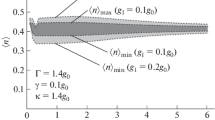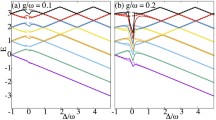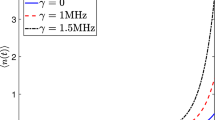Abstract
We in this paper investigate the spin squeezing in relation with the phase transition from the normal to superradiant phases for two atoms in an optical cavity. The squeezing vanishes in the normal phase and jumps sharply to the maximum bound above the critical point of phase transition. In the high atom-field coupling regime, the squeezing vanishes again when the atom-field coupling reaches a threshold value. The squeezing alternates between two spin components in the intermediate region of atom-field coupling. An interesting observation is that the two spin components are squeezed alternately with the variation of phase angle of the cavity field. The squeezing factor indeed can be used to probe the phase transition and coherent-field properties as well.
Similar content being viewed by others
Avoid common mistakes on your manuscript.
1 Introduction
Spin squeezing, arising from quantum correlation, has attracted widespread attention in various branches of physics [1,2,3] since it has been put forward first in the pioneering work [4]. Several rigorous definitions have been proposed to quantify it [5,6,7,8]. In practice, a spin state is regarded as squeezed if one spin component satisfies the inequality relation \(({\Delta } S_{j})^{2}-\frac {1}{2}|\left \langle S_{Z}\right \rangle |<0\) (j = X,Y). Recently, Lots of efforts have been devoted to spin squeezing due to its potential applications in atomic clocks [9,10,11], gravitational-wave interferometers [12], high-resolution spectroscopy [5], entanglement detection [13] and quantum metrology [14]. The preparation of spin squeezing states has become the important subject of theory and experiment in various physical systems such as Bose-Einstein condensates (BECs) [15,16,17], atomic systems in cavities [18,19,20] and NV centers [21]. The best experiment today has achieved 20 dB squeezing with ultracold Rb atoms in a natural atomic trap [22].
Since any real quantum systems inevitably interact with their environments [23,24,25], much attention has been paid to the influences of environments on spin squeezing [26, 27]. For example, the spin squeezing for an ensemble of N independent spin-1/2 particles was investigated with the help of the Hierarchy equation method under non-Markovian channels [28]. The squeezing properties of a two-level atom coupled to a non-Markovian reservoir were also revealed by means of the exact solution [29]. The squeezing dynamics of two non-interacting atoms off-resonantly coupled to non-Markovian reservoirs was studied by the time-convolutionless master equation approach [30]. To fight against decoherence and improve quantum squeezing, the optimal control technique [31] and dynamical decoupling technique [32, 33] have been employed recently. What is more, robust spin squeezing preservation in photonic crystal cavities was also explored in [34] by modifying detuning.
However, most of these achievements are related to atomic ensembles, few works have been done for the study of two-atom squeezing dynamics. In this setting, we in this paper investigate the spin squeezing of two atoms coupled to an optical cavity to explore the field-interaction effect on the spin squeezing. The analytical squeezing factor is obtained by means of coherent-state variational method showing the explicit relation with the Dicke phase transition from normal phase (NP) to the superradiant phase (SP).
This paper is organized as follows. In Section 2, we present the Hamiltonian of two atoms in an optical cavity and the formalism of variational method. The Section 3 devotes the spin squeezing in the presence of optical cavity environment. Finally, a brief summary is given in Section 4.
2 The Hamiltonian for two-atom in a optical cavity and variational method
A composite system of two atoms subjected in a one-mode optical cavity of frequency ω is described by the Hamiltonian (\(\hslash =1\))
under the rotating-wave approximation, where the ω0 is the transition frequency of two-level atom between the excited state and ground state. The Pauli matrices \({\sigma _{i}^{z}}\), \(\sigma _{i}^{\pm }=({\sigma _{i}^{x}}\pm i{\sigma _{i}^{y}})/2\) are defined as usual for the two-atom pseudospin operators. a (a‡) is the annihilation (creation) operator of the single-mode cavity field and g is the coupling constant.
We consider the stationary states of Hamiltonian (1) in the semiclassical-field approximation. Taking the average of Hamiltonian (1) in the optical coherent state \(\left \vert \alpha \right \rangle \) (a|α〉 = α|α〉), we obtain an effective spin Hamiltonian
in which the complex eigenvalue of the photon annihilation operator is parameterized as
with γ2 = 〈α|a‡a|α〉 being the average photon number. The effective spin Hamiltonian Hsp(α) can be diagonalized in the two-qubit bases \(\{|e_{1}\rangle =\left \vert +,+\right \rangle \), \(|e_{2}\rangle =\left \vert +,-\right \rangle \), \(|e_{3}\rangle =\left \vert -,+\right \rangle \), \(|e_{4}\rangle =\left \vert -,-\right \rangle \}\) with the energy eigenvalues given by
where \(Q=\sqrt {{\Gamma }^{2}+{\omega _{0}^{2}}},{\Gamma } =2g\gamma \). The corresponding semi-classical eigenstates are seen to be
with the parameters given by
The trial eigenstates are the functions of field variable γ, which can be regarded as a variational parameter with the trail wave function
wherei = 0,1,2,3. The stationary states and energies can be obtained in terms of the standard variational method.
The stationary states are realized as the local minima of energy functions εi(γ). For the state \(\left \vert \psi _{0}\right \rangle \), the energy extremum condition is
which possesses always a zero photon-number solution γ = 0 and a non-zero photon number solution
The local minimum of energy corresponds to the positive second-order derivative of energy function for the zero-photon state
which gives rise to the boundary value of the atom-field coupling
between the zero (when g < gc) and nonzero (g > gc ) photon states. It is interesting to remark that the critical coupling value is exactly the same as that in the Dicke model [35, 36]. For \(\left \vert \psi _{3}\right \rangle \), the energy extremum condition is found as
which possesses always a zero photon number solution, while the nonzero photon number solution does not exist. The states \(\left \vert \psi _{1}\right \rangle \) and \(\left \vert \psi _{2}\right \rangle \) are also stable when the average photon number is zero. Similar to the Dicke model case, we may call the stable state of zero photon number as normal phase (NP) and the non-zero one as superradiant phase (SP).
It is the main goal of the present paper to investigate the cavity-field induced spin-squeezing in the NP and SP for the state \(\left \vert \psi _{0}\right \rangle \) with the energy eigenvalue ε0, which is the ground state of the system considered. The density matrix of NP can be written in the two-qubit bases as
and the density matrix of SP is evaluated as
3 Optical-cavity induced two-atom pseudospin squeezing
We introduce collective operators Sl (l = x,y,z) for the two atoms
which have the standard spin commutation relation \(\left [S_{x},S_{y}\right ] =iS_{z}\). The Heisenberg uncertainty relation is given by
where \({\Delta } S_{l}=\sqrt {\left \langle {S_{l}^{2}}\right \rangle -\left \langle S_{l}\right \rangle ^{2}}\) (l = x,y). Consequently, the collective spin component Sl is said to be squeezed if the fluctuation of it satisfies the inequality condition
or
which serves as squeezing factor. The spin average is evaluated over the density matrix ρ of the ground state \(\left \vert \psi _{0}\right \rangle \) such that \(\left \langle S_{l}\right \rangle =Tr(S_{l}\rho )\). Then, inserting \(\left \langle S_{l}\right \rangle \) and \(\left \langle {S_{l}^{2}}\right \rangle \) into (17) or (18), we are able to analyze numerically the squeezing properties depending on the cavity-atom coupling g and field phase-angle ϕ in (3).
Figure 1 shows the variation of atomic squeezing with respect to the phase angle ϕ of the optical coherent state and atom-cavity coupling g. The squeezing factor Fl is zero in the NP below the critical point (g < gc), where the two atoms are in the pseudospin state denoted by \(\left \vert \psi _{0}^{NP}\right \rangle =|1,-1>\), which is the extremum state Sz|1,− 1 >= − 1|1,− 1 > satisfying the minimum uncertainty of angular momentum operator of (16). Physically both atoms are populated in the lower level of energy eigenstate in the NP. The squeezing factors Fx (a), Fy (b) vary with both coupling g and phase angle ϕ in the SP induced by the cavity field. The dark blue region with negative value indicates the spin squeezing of one component Sx or Sy. The higher value of Fx corresponds to the lower value of Fy and vice versa. The phase angle dependence is periodic. In other words, the two components Sx and Sy are alternatively squeezed by the variation of phase angle ϕ.
Figure 2 is the plot of squeezing factors Fx (a) and Fy (b) versus coupling strength g for fixed phase angles ϕ = 0 (green solid line), π/6 (red dot-dash line), π/3 (blue dash line) and π/2 (black dot line) in the resonance condition (ω0 = ω). The squeezing factor Fx (Fy) jumps sharply down to the lowest bound above the critical point gc for phase angle ϕ = 0 (π/2). Then it attempts to zero gradually with the increase of coupling strength and becomes zero again after a sharp positive peak in the higher coupling region.
In Fig. 3, the squeezing factor Fx in the red detuning region (ω0 > ω) is plotted as a function of coupling strengthg with phase angle ϕ = 0 (a), π/6 (b) for atomic frequency ω0 = 2ω (green solid line), 10ω (red dot-dash line), 30ω (blue dash line). The zero region of squeezing factor, which characterizes the NP, expands with the increase of atomic frequency. The squeezing for phase angle ϕ = 0 (a) is higher than that of π/6 (b) with the similar g dependence as in the resonance case (Fig. 2). The corresponding squeezing factor curves Fx are displayed in Fig. 4 for the blue detuning (ω0 < ω) with ω0 = 0.5ω (green solid line), 0.1ω (red dot-dash line), and 0.05ω (blue dash line). The critical point gc shifts to the lower value direction with the decrease of atomic frequency. The x-component of spin has a sharp squeezing just above the critical point for ϕ = 0. The spin coherent state is then returned with the increase of coupling g shown by the vanishing Fx = 0. The inserts of Fig. 4a and b display the detail of curves in the squeezed region. The sharp peak of Fx indicates the squeezing of component Sx.
4 Results and discussion
In conclusion, the spin squeezing for two atoms trapped in an optical cavity is investigated based on the photon coherent-state variational method along with the Dicke phase transition. The zero squeezing factor in the NP indicates minimum uncertainty nature of the two-atom pseudospin state. While the spin squeezing takes place just above the phase transition point gc. The spin squeezing factor is periodic with respect to the phase angle of coherent optical field. It tends to zero in the strong atom-field coupling regime above a threshold value. While the two spin-components are squeezed alternately in the intermediate region of atom-field coupling. The spin squeezing indeed can serve as a probe to detect the Dicke phase transition and cavity field properties as well.
References
Ma, J., Wang, X., Sun, C.P., Nori, F.: Phys. Rep. 509, 89 (2011)
Wang, X., Sanders, B.C.: Phys. Rev. A 68, 012101 (2003)
Pezzè, L., Smerzi, A., Oberthaler, M.K., Schmied, R., Treutlein, P.: Rev. Mod. Phys. 90, 035005 (2018)
Kitagawa, M., Ueda, M.: Phys. Rev. A 47, 5138 (1993)
Wineland, D.J., Bollinger, J.J., Itano, W.M., Heinzen, D.J.: Phys. Rev. A 50, 67 (1994)
Søensen, A.S., Mømer, K.: Phys. Rev. Lett. 86, 4431 (2001)
Tóth, G., Knapp, C., Gühne, O., Briegel, H.J.: Phys. Rev. Lett. 99, 250405 (2007)
Zhang, Z., Duan, L.M.: New J. Phys. 16, 103037 (2014)
Ye, J., Kimble, H.J., Katori, H.: Science 320, 1734 (2008)
André, A., Sørensen, A.S., Lukin, M.D.: Phys. Rev. Lett. 92, 230801 (2004)
Meiser, D., Ye, J., Holland, M.J.: New J. Phys. 10, 073014 (2008)
Goda, K., Miyakawa, O., Mikhailov, E.E., Saraf, S., Adhikari, R., McKenzie, K., Ward, R., Vass, S., Weinstein, A.J., Mavalvala, N.: Nat. Phys. 4, 472 (2008)
Gühne, O., Tóth, G.: Phys. Rep. 474, 1 (2009)
Muessel, W., Strobel, H., Linnemann, D., Hume, D.B., Oberthaler, M.K.: Phys. Rev. Lett. 113, 103004 (2014)
Gross, C., Zibold, T., Nicklas, E., Estève, J., Oberthaler, M.K.: Nature (London) 464, 1165 (2010)
Bücker, R., Grond, J., Manz, S., Berrada, T., Betz, T., Koller, C., Hohenester, U., Schumm, T., Perrin, A., Schmiedmayer, J.: Nat. Phys. 7, 608 (2011)
Huang, X.Y., Sun, F.X., Zhang, W., He, Q.Y., Sun, C.P.: Phys. Rev. A 95, 013605 (2017)
Masson, S.J., Parkins, S.: Phys. Rev. A 99, 023822 (2019)
Zhang, Y.C., Zhou, X.F., Zhou, X., Guo, G.C., Zhou, Z.W.: Phys. Rev. Lett. 118, 083604 (2017)
Masson, S.J., Barrett, M.D., Parkins, S.: Phys. Rev. Lett. 119, 213601 (2017)
Xia, K., Twamley, J.: Phys. Rev. B 94, 205118 (2016)
Hosten, O., Engelsen, N.J., Krishnakumar, R., Kasevich, M.A.: Nature (London) 529, 505 (2016)
Breuer, H.P., Petruccione, F.: The Theory of Open Quantum Systems. Oxford University Press, Oxford (2002)
Breuer, H.P., Laine, E.M., Piilo, J., Vacchini, B.: Rev. Mod. Phys. 88, 021002 (2016)
de Vega, I., Alonso, D.: Rev. Mod. Phys. 89, 015001 (2017)
Sun, Z.: Phys. Rev. A 84, 052307 (2011)
Mirkhalaf, S.S., Smerzi, A.: Phys. Rev. A 95, 022302 (2017)
Yin, X., Ma, J., Wang, X., Nori, F.: Phys. Rev. A 86, 012308 (2012)
Xiao, X., Fang, M.F., Hu, Y.M.: Phys. Scr. 84, 045011 (2011)
Zou, H.-M., Fang, M.F., Yang, B.Y.: Chin. Phys. B 22, 120303 (2013)
Pichler, T., Caneva, T., Montangero, S., Lukin, M.D., Calarco, T.: Phys. Rev. A 93, 013851 (2016)
Tan, Q.-S., Huang, Y., Kuang, L.-M., Wang, X.: Phys. Rev. A 89, 063604 (2014)
Li, J.-Q., Du, L., Liang, J.-Q.: Laser Phys. 28, 095202 (2018)
Zhong, W.-J., Li, Y.-L., Xiao, X., Xie, Y.-M.: Laser Phys. Lett. 13, 085205 (2016)
Zhao, X., Liu, N., Liang, J.-Q.: Phys. Rev. A 90, 023622 (2014)
Zhao, X., Liu, N., Bai, X., Liang, J.-Q.: Ann. Phys. 378, 448 (2017)
Acknowledgments
This work was supported by the Natural Science Foundation of China under Grants Nos. 11105087, 11275118, 11404198 and the natural science foundation of Shanxi Province under Grant No. 201701D221001. This work was also sponsored by the Fund for Shanxi “1331 Project” Key Subjects Construction.
Author information
Authors and Affiliations
Corresponding author
Additional information
Publisher’s Note
Springer Nature remains neutral with regard to jurisdictional claims in published maps and institutional affiliations.
Rights and permissions
About this article
Cite this article
Bai, XM., Bai, XY., Liu, N. et al. Spin Squeezing for Two Atoms in an Optical Coherent-State Cavity. Int J Theor Phys 59, 173–180 (2020). https://doi.org/10.1007/s10773-019-04308-z
Received:
Accepted:
Published:
Issue Date:
DOI: https://doi.org/10.1007/s10773-019-04308-z








